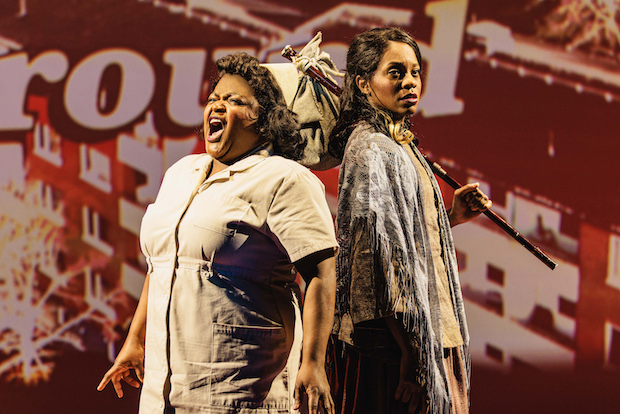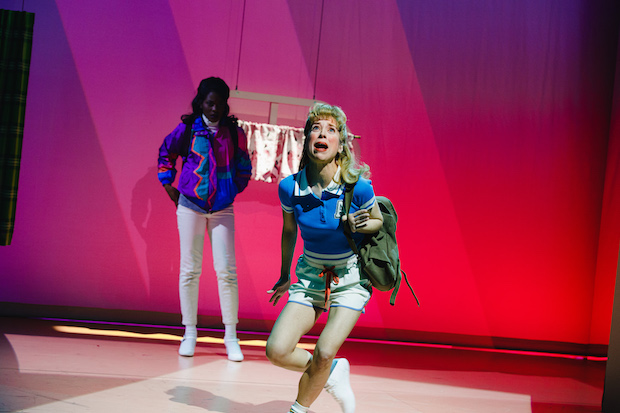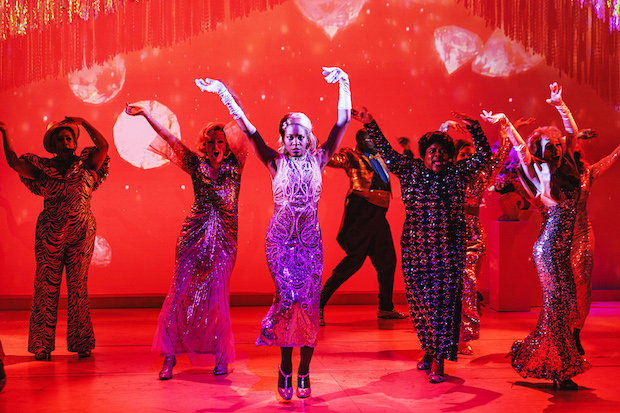Review: White Girl in Danger Depicts the Hostile Takeover of an All-White Soap Opera

(© Marc J. Franklin)
Like a character in Michael R. Jackson’s White Girl in Danger, who perhaps speaks for the playwright himself, I too spent my preschool years consuming daytime soap operas at the knee of an older caretaker (my grandmother), learning the contours of human behavior from screaming white women in sparkly gowns. How this impacted my adult taste in drama is up to my readers to judge. But in Jackson, it has produced the most fascinating new musical of the season, a messy masterpiece that is at turns cruel, hilarious, unhinged, and trenchant. I found myself regularly cringing, if only in recognition of an authentic reflection of American culture staring back at me in the funhouse mirror.
It’s set in the soap opera town of Allwhite, home of rich bad girl Megan (Molly Hager), middle-class victim Meagan (Lauren Marcus), and poor overachiever Maegan (Alyse Alan Louis in a truly alarming performance). As the name suggests, their storylines are exclusively white, with the “Blackground” characters relegated to separate (and unequal) stories about slavery and police violence. But Keesha Gibbs (a magnetic and slightly terrifying Latoya Edwards) wants more — she wants to be a part of their world.
“Aw, Keesha! Our lives of nonstop pain and sorrow ain’t so bad! And without Police Violence Story Time, we wouldn’t matter at all,” says Caroline (Ciarra Alyse Harris at the performance I attended). Her words, and the warnings of Keesha’s mother Nell (Tarra Conner Jones), go unheeded when the Allwhite Writer (a disembodied God-like voice) promotes Keesha to the role of “Best Friend” to the Megans. But will Keesha ever truly be satisfied in a supporting role? Of course not! Within days she stages a coup, which she describes as “an interblacktional bleminist movement that will liberate all Blackgrounds!” One wonders if this high-minded rhetoric is just frosting on a cake made of yeasty personal ambition.

(© Marc J. Franklin)
Jackson, who wrote book, music, and lyrics for last season’s Tony Award-winning musical A Strange Loop, repeats that creative trifecta with an energetic and bitingly satirical new work: Nell’s second act number, “Why I Kill,” seems to be a sendup of every showstopping showtune sung by a Black woman (but mostly “I Know Where I’ve Been” from Hairspray), with the audience eagerly playing its typical role by whooping during the final glory note (Jones earns it, although I’ll never understand the custom of appreciating a vocalist by shouting over them).
“The Anti-Allwhite Diamond Fashion Show” opens the second act with an artillery blast aimed directly at conspicuous consumption dressed up as activism. Some viewers will undoubtedly recoil from the violent lyrics in “Murder Me, Please Daddy,” but it would be difficult to argue that it is an unfair portrayal of the carnival of misogynist violence that constitutes so much American entertainment.
In his book and lyrics, Jackson has created a musical that is both more challenging than A Strange Loop and regularly less coherent as he sprays the audience with a torrent of made-up words: “Whitezerland,” “misogynoirhoids,” “BICOC” (an acronym for “Blackground Indigenous Character of Color”). Jackson’s wordplay betrays a writer who is both very online and highly critical of the turgid language of social justice (read: media). His gleeful mockery of this fashionable nonsense is one of the things that makes White Girl in Danger so thrilling to experience. It’s also the greatest source of disappointment in this production.

(© Marc J. Franklin)
Under the direction of Lileana Blain-Cruz, White Girl in Danger suffers from persistent sound balance issues, with the band regularly overpowering the vocalists and drowning out the lyrics (sound design by Jonathan Deans). Add to this a hectic pace that has actors stumbling over their lines (perhaps to keep this two hour, 45-minute musical from bumping up against three hours) and you have a recipe for disaster — or, at least, the audience missing out on a sizable chunk of what the playwright is saying.
In fairness to Blain-Cruz, who more successfully affected controlled chaos in last season’s revival of The Skin of Our Teeth, she had the nearly impossible task of staging the caffeinated daydreams of a playwright with a lot to say. In some ways, she succeeded: Adam Rigg’s versatile set (painted in Caucasian nude) facilitates the constant churn of this aggressively cinematic fantasy. So does Raja Feather-Kelly’s spectacular choreography, which is made even flashier by Jen Schriever’s frenetic lighting — it’s the off-Broadway equivalent of a Vegas floorshow. Projection designer Josh Higgason and cinematographer Derrick Woodyard supplement an already busy stage picture with filmed teasers and commercials. And Montana Levi Blanco’s costumes chart the social changes in Allwhite while also distinguishing multiple characters played by the same actor.

(© Marc J. Franklin)
Liz Lark Brown impressively does triple duty as the mothers of all three Megans, while Eric William Morris does the same as the male love interests: Matthew Scott, Scott Matthew, and Zack Paul Gosselar. It’s a comment on the interchangeability of these roles (at least how they’ve been traditionally cast) presented with ridiculous theatricality, which everyone in this cast works hard to maintain.
James Jackson Jr. gives a particularly memorable performance as a mysterious character who reveals himself late in the show, delivering the most uncomfortable and essential monologue of the entire evening, as well as a song that really shouldn’t work but somehow does.
Despite its flaws, White Girl in Danger is a musical bursting with big ideas about the transactional relationship between storytellers and consumers (which is what American audiences are). It also highlights the ways our obsession with race obfuscates persistent class disparities. Jackson boldly obliterates contemporary manners while dreaming of a day when individuals can tell their stories without having to cram themselves onto a shelf in the store. That makes White Girl in Danger a must-see new musical from one of the sharpest voices in the theater today.











